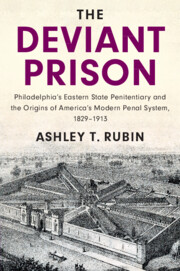 The Deviant Prison
The Deviant Prison from Part II - THE ADVANTAGE OF DIFFERENCE: The Process of Institutionalization
Published online by Cambridge University Press: 12 January 2021
This chapter describes what the Pennsylvania System looked like in practice, focusing on deviations from the Pennsylvania System's idealized regimen that its administrators vehemently defended. Quite at odds with their extensive public proclamations of their system's excellence, the administrators often subverted the Pennsylvania System's ultimate goals or directly broke its most central rules. This chapter explains the administrators' apparently paradoxical behavior by demonstrating that these deviations were part of an effort to reduce the Pennsylvania System's vulnerability to further criticism. Their management decisions at the prison were intensely pragmatic, guided not by a perfect belief in the Pennsylvania System or even penological goals, but by the desire to reduce expenses and prevent insanity—the Pennsylvania System's biggest weaknesses according to its critics. The administrators sought to prevent manifestations of the calumnious myths so they could continue to claim their system's superiority and protect their own status as benevolent, humane gentlemen running a model prison—a status that kept the Pennsylvania System personally institutionalized at Eastern.
To save this book to your Kindle, first ensure [email protected] is added to your Approved Personal Document E-mail List under your Personal Document Settings on the Manage Your Content and Devices page of your Amazon account. Then enter the ‘name’ part of your Kindle email address below. Find out more about saving to your Kindle.
Note you can select to save to either the @free.kindle.com or @kindle.com variations. ‘@free.kindle.com’ emails are free but can only be saved to your device when it is connected to wi-fi. ‘@kindle.com’ emails can be delivered even when you are not connected to wi-fi, but note that service fees apply.
Find out more about the Kindle Personal Document Service.
To save content items to your account, please confirm that you agree to abide by our usage policies. If this is the first time you use this feature, you will be asked to authorise Cambridge Core to connect with your account. Find out more about saving content to Dropbox.
To save content items to your account, please confirm that you agree to abide by our usage policies. If this is the first time you use this feature, you will be asked to authorise Cambridge Core to connect with your account. Find out more about saving content to Google Drive.